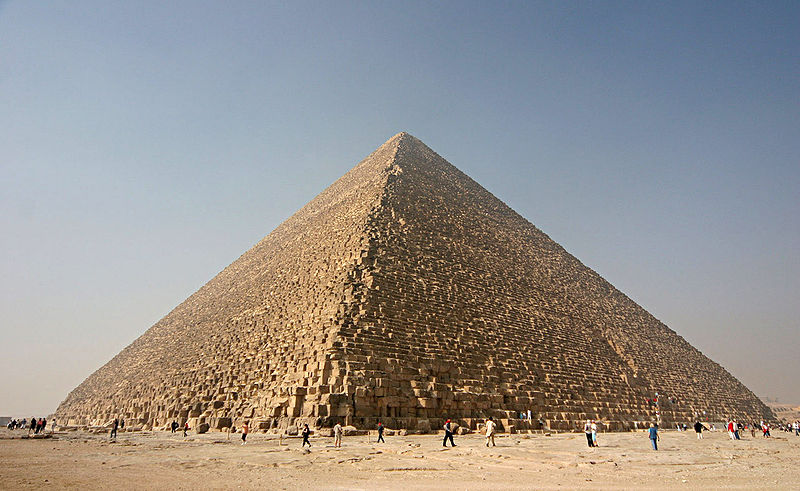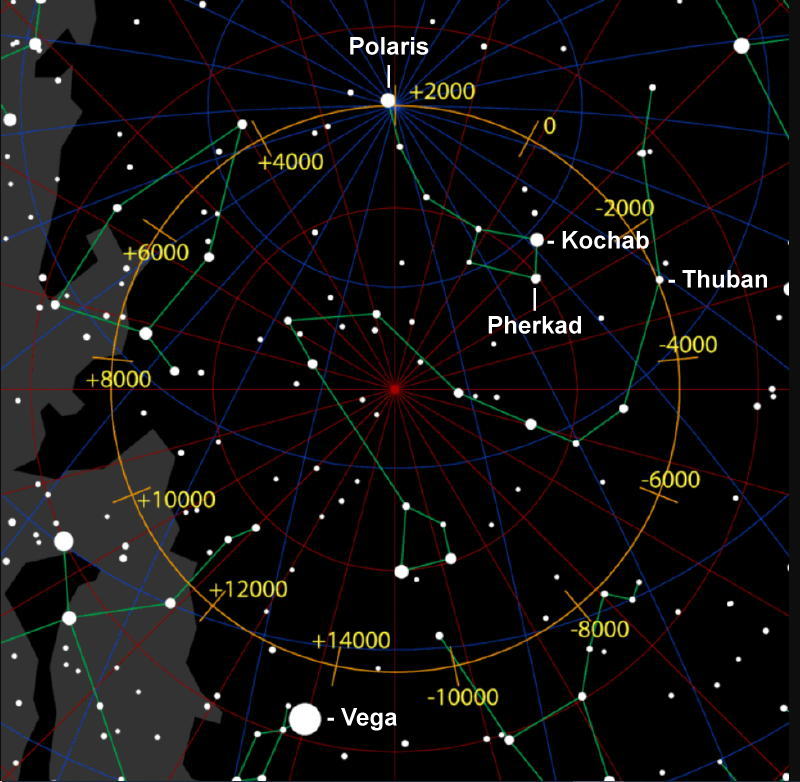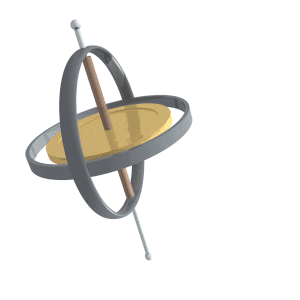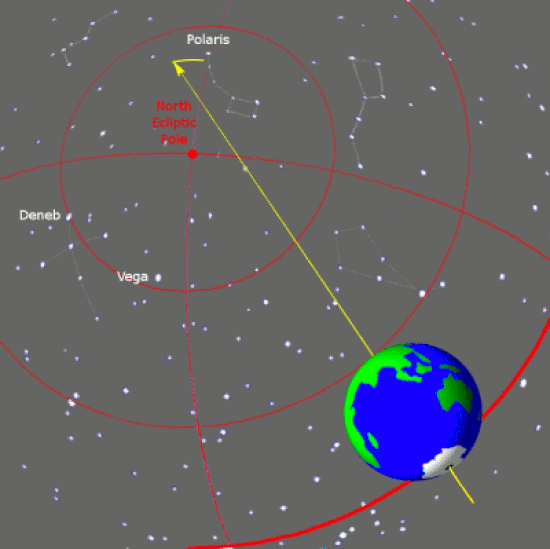
Thuban is not a particularly bright star, but it holds a special place in the hearts of stargazers. That’s because Thuban – a relatively inconspicuous star in the constellation Draco the Dragon – was the pole star some 5,000 years ago, when the Egyptians were building the pyramids. It’ll be the pole star again in the year 20,346 CE. You wonder what humanity will be doing then.
The pyramids and Thuban
Among the many mysteries surrounding Egypt’s pyramids are the so-called “air shafts” in the Great Pyramid of Giza. Originally, we believed these narrow passageways were for ventilation while building the pyramids. In the 1960s, though, we realized the air shafts aligned with stars or areas of sky as the sky appeared for the pyramids’ builders 5,000 years ago.
One of the “air shafts” follows a crooked course through the Great Pyramid, so you couldn’t have sighted stars through it. To this day, the purpose of these passageways inside the Great Pyramid isn’t clear, although they might have been connected to rituals associated with the king’s ascension to the heavens. Whatever their purpose, the Great Pyramid of Giza reveals that its builders knew the starry skies intimately.
They surely knew Thuban was their pole star, the point around which the heavens appeared to turn.

Past and future pole stars
Indeed, Thuban at times made a better pole star than our modern Polaris. Various sources claim that Thuban almost exactly pinpointed the position of the north celestial pole in the year 2787 BCE.
Meanwhile, our modern Polaris – which many centuries ago was an ordinary star known by the name Phoenice – won’t match Thuban’s precision when it most closely aligns with the north celestial pole on March 24, 2100. Polaris will be 27′ 09″ (0.4525 degrees) from the north celestial pole at that time (a little less than the angular diameter of the moon when at its farthest from Earth), according to the computational wizard Jean Meeus.
The Northern Hemisphere also has had long stretches without a pole star. After the reign of Thuban but before that of Polaris, Kochab in the Little Dipper served as a rather poor pole star in 1100 BCE. Kochab was only half again as close to the north celestial pole as it is today.
Looking into the future, Errai will become the northern pole star around 4000 CE, and Alderamin will take its turn around 7500 CE.

Why does the identity of the pole star keep changing?
Earth’s axis maintains a tilt that varies from about 22 degrees to 24 degrees from perpendicular every 41,000 years with respect to the plane of our orbit around the sun. But, over a period of 26,000 years, Earth’s axis points out at different pole stars, tracing out a slow circle in the heavens. Whichever star lies on or near that circle will eventually be a pole star.
Many compare this motion of Earth – called precession or sometimes precession of the equinoxes – to that which you sometimes see in a spinning top wobbling before it falls.

How to see Thuban
Thuban is part of the constellation Draco the Dragon. Although it’s not a super bright star, it is bright enough to see with relative ease on a dark night.
Most people star-hop to Thuban from the Big and Little Dippers.

Enjoying EarthSky so far? Sign up for our free daily newsletter today!
Bottom line: The pole stars change over time. Thuban was the Pole Star some 5,000 years ago, when the Egyptians were building the pyramids.
The post Thuban was the Pole Star when the pyramids were being built first appeared on EarthSky.
from EarthSky https://ift.tt/uqGKTcv

Thuban is not a particularly bright star, but it holds a special place in the hearts of stargazers. That’s because Thuban – a relatively inconspicuous star in the constellation Draco the Dragon – was the pole star some 5,000 years ago, when the Egyptians were building the pyramids. It’ll be the pole star again in the year 20,346 CE. You wonder what humanity will be doing then.
The pyramids and Thuban
Among the many mysteries surrounding Egypt’s pyramids are the so-called “air shafts” in the Great Pyramid of Giza. Originally, we believed these narrow passageways were for ventilation while building the pyramids. In the 1960s, though, we realized the air shafts aligned with stars or areas of sky as the sky appeared for the pyramids’ builders 5,000 years ago.
One of the “air shafts” follows a crooked course through the Great Pyramid, so you couldn’t have sighted stars through it. To this day, the purpose of these passageways inside the Great Pyramid isn’t clear, although they might have been connected to rituals associated with the king’s ascension to the heavens. Whatever their purpose, the Great Pyramid of Giza reveals that its builders knew the starry skies intimately.
They surely knew Thuban was their pole star, the point around which the heavens appeared to turn.

Past and future pole stars
Indeed, Thuban at times made a better pole star than our modern Polaris. Various sources claim that Thuban almost exactly pinpointed the position of the north celestial pole in the year 2787 BCE.
Meanwhile, our modern Polaris – which many centuries ago was an ordinary star known by the name Phoenice – won’t match Thuban’s precision when it most closely aligns with the north celestial pole on March 24, 2100. Polaris will be 27′ 09″ (0.4525 degrees) from the north celestial pole at that time (a little less than the angular diameter of the moon when at its farthest from Earth), according to the computational wizard Jean Meeus.
The Northern Hemisphere also has had long stretches without a pole star. After the reign of Thuban but before that of Polaris, Kochab in the Little Dipper served as a rather poor pole star in 1100 BCE. Kochab was only half again as close to the north celestial pole as it is today.
Looking into the future, Errai will become the northern pole star around 4000 CE, and Alderamin will take its turn around 7500 CE.

Why does the identity of the pole star keep changing?
Earth’s axis maintains a tilt that varies from about 22 degrees to 24 degrees from perpendicular every 41,000 years with respect to the plane of our orbit around the sun. But, over a period of 26,000 years, Earth’s axis points out at different pole stars, tracing out a slow circle in the heavens. Whichever star lies on or near that circle will eventually be a pole star.
Many compare this motion of Earth – called precession or sometimes precession of the equinoxes – to that which you sometimes see in a spinning top wobbling before it falls.

How to see Thuban
Thuban is part of the constellation Draco the Dragon. Although it’s not a super bright star, it is bright enough to see with relative ease on a dark night.
Most people star-hop to Thuban from the Big and Little Dippers.

Enjoying EarthSky so far? Sign up for our free daily newsletter today!
Bottom line: The pole stars change over time. Thuban was the Pole Star some 5,000 years ago, when the Egyptians were building the pyramids.
The post Thuban was the Pole Star when the pyramids were being built first appeared on EarthSky.
from EarthSky https://ift.tt/uqGKTcv

Aucun commentaire:
Enregistrer un commentaire